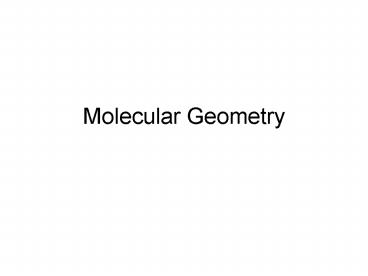Molecular Geometry - PowerPoint PPT Presentation
1 / 17
Title:
Molecular Geometry
Description:
Molecular Geometry. Bonding. Covalent bonds occur when atoms are at an ideal ... one covalent bond, polarity depends on individual bonds and shapes of molecules. ... – PowerPoint PPT presentation
Number of Views:43
Avg rating:3.0/5.0
Title: Molecular Geometry
1
Molecular Geometry
2
Bonding
- Covalent bonds occur when atoms are at an ideal
distance from one another. - At this distance attractive forces predominate
repulsive forces. - Too close the atoms repel each other. Too far
away they do not attract
3
Bonding
4
Polarity of Polyatomic Molecules
- Recall polar covalent bonds
- For molecules with more than one covalent bond,
polarity depends on individual bonds and shapes
of molecules. - Considering HCl, the molecule is polar because of
the shape and electronegativity differences.
5
Polarity of Polyatomic Molecules
- Consider CO2
- VESPR model signifies linear molecular shape
- C-O bond is polar
- CO2 molecule nonpolar
- Overall molecular polarity is the vector sum of
individual dipoles
6
Polarity of Polyatomic Molecules
- Consider H2O
- We know it is a polar molecule
- H-O bonds are polar
- VESPR model predicts tetrahedral bent molecular
shape - Vector of polarity proves overall polar molecule
7
Polarity of Polyatomic Molecules
- Predict if CCl4 and CHCl3 are polar.
8
Covalent Bonding and Orbital Overlap
- When covalent bonds occur we say the orbitals
overlap.
9
Multiple Bonds
- So far we have considered only s bonds.
- In a s bond the e- density is concentrated about
the nuclear axis can occur with p or s orbital. - In a multiple bond overlap within the p orbital
occurs perpendicular to the nuclear axis - The said perpindicular overlap of p orbitals
produces a p bond
10
Multiple Bonds
- Consider ethene 1 s, 1 p
11
Delocalized e-
- e- localized when e- are associated w/ p and s
bonds keeping them with 2 atoms. - Delocalized e- can be associated w/ many atoms.
Associated with resonance structures. - Benzene
12
Delocalized e-
- In benzene, neither of the two Lewis resonance
structures are correct. - The p e- are spread throughout the entire
molecule giving the molecule incredible
stability.
13
Molecular Orbital Theory
- The theory assigns the electrons in a molecule to
a series of orbitals that belong to the molecule
as a whole. - relate them to the probability of finding
electrons in certain regions of a molecule.
14
Molecular Orbital Theory
- Whenever two atomic orbitals overlap, two
molecular orbitals form. - The lower energy MO concentrates e- density
between the nuclei is the bonding molecular
orbital. - The higher energy MO has little e- density
between nuclei is the antibonding molecular
orbital, signified by a
15
Molecular Orbital Theory
- If the e- density is centered about the nucleus
it is a s molecular orbital - Often represented in energy level diagrams, note
s1s lower energy that s1s
16
Molecular Orbital Theory
- If electrons are not placed in the s1s orbital
they must be placed in s1s - Take theoretical molecule He2
17
Molecular Orbital Theory
- Bond Order ½ (if bonding e- - of antibonding
e-) - Bond order relates to the stability of covalent
bonds - Bond order of 0 represents no bonds
- 1 represents single, 2 represents double 3
represents triple































